Mary Gardens Explored
Mary Gardens Explored
Wayside Flowers and Shrines of Our Lady
- John S. Stokes Jr.
As we come to know the growth and blooming of the Flowers of Our Lady in our Mary Gardens, we acquire a heightened alertness to their presence also in the neighborhoods and waysides through which we travel. Thus discovered they evoke our reflections and prayers in a spontaneous and ever-changing way as we move about, as distinct from the familiar reflections in our gardens. As Judith Smith observes in The Mary Calendar, "Every field path and (becomes) an illuminated Book of Hours."
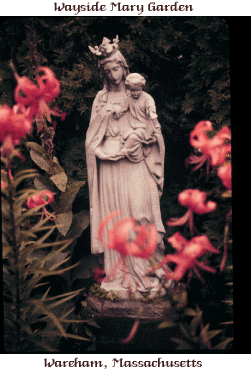
This is a return to the spirituality of medieval times, when symbolical flowers were characteristically encountered in and gathered from the countrysides rather than gardens. In this period, when people traveled mostly afoot, flower prayers were focused not by garden statues or grottos of Our Lady, but by wayside shines or field crosses encountered as they moved about.
Happily, this quickening is also available to us in the present day, for in our alertness to find the Flowers of Our Lady in roadsides and fields, we from time to time discover statues and shrines of Our Lady placed there - mostly in front yards, but sometimes also along waysides. Two such shrines stand out in our own experience.
The first was one we discovered while driving through Wareham, Massachusetts in the 1960s (on the way to visit the Garden of Our Lady in Woods Hole). Surveying front yards as we passed, we noted a large garden with a trellised fence, above the entrance to which was a sign, "God's Garden," with an invitation for passers by to enter. Stopping our car and entering, we beheld a large statue of Our Lady surrounded by lilies, as can be seen from the accompanying photo. In future years, we would look forward to stopping for a visit to this wayside garden each time as we passed by on our annual pilgrimage to Woods Hole.
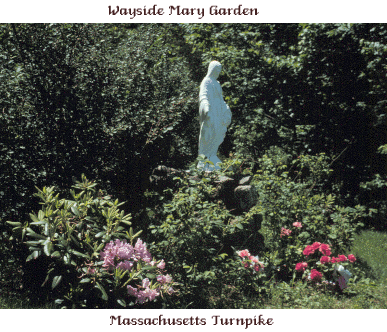
We discovered the second while making a trip from Boston to Springfield in the 1980s. Several miles past the Hartford turnpike exit of the Massachusetts turnpike we came upon a large shrine set back from the south side of the road. We pulled up on the north side of the divided highway to view it as best we could; and then on the return trip several days later we were able to stop for a while on the south side and walk over to the shrine, taking the accompanying photo.
In addition to tubbed plants, evidently rotated so there would always be seasonal blooms, there was a lovely grassy mead in front of the shrine filled with bluets (Eyes of Mary) and bordered with orange hawkweed (Our Lady's Paintbrush).
There were no buildings in sight, only a pathway leading into the woods behind the shrine. We later wrote a letter to the neighboring parish church asking about it but received no reply. On trips to Hartford over the following several years we would continue on the turnpike past the Hartford exit to visit the shrine, with a prayer of gratitude for those responsible for it, and then circle back to the exit.
From this searching of nature for flower symbols and images of the Virgin, we came in time to see all the countryside as a spiritual mirror. A memorable experience was that of several motor trips one mid summer and fall travelling between Pennsylvania and Massachusetts through the extensive roadsides and fields of goldenrod - known in some parts of Germany as "Heavenly Radiance" (Himmel-Brand).
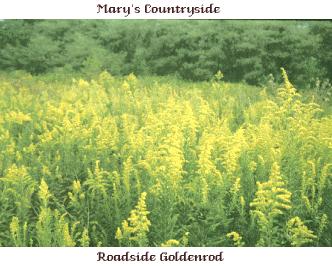
Immersed in this golden beauty, we would rise in contemplation of the awesome beauty of the Creator. On returning to earth, as it were, we would then see the goldenrod as infused and radiant with God's aura, which we would follow back to its source in the divine radiance. Emerging then with the full rays of this radiance we would see it as flooding the entire sky and countryside, now seen as God's face, our interface with God, resplendantly showing forth the Divinity.
On a final trip that fall we approached Boston in the late afternoon with the sun behind us. Suddenly, just as the Boston buildings came into view before us, the angle of the road changed such that the sun behind us, shining momentarily through the rear window of the car, reflected on us and bathed us triply, from the main and side mirrors, in an explosion of light - imparting a startling sense of entrance into the glory of the Heavenly City.
From such spiritual illuminations of the countryside, following upon the unfolding illuminative discoveries of the symbolical Flowers of Our Lady as we worked in our Mary Gardens through the years, we realized that there was a profound providential correspondence or synchronicity between the inner human spirit and the workings of the active imagination as one beheld or encountered the forms of nature. It would have been strange if our loving Creator had not given us, along with all the poetic imagery of nature, forms we could discover as symbolic of the divine Persons and of the plan of our Creation and Redemption. And this provided insight into how the flower symbols of Our Lady were discovered, named and used through the centuries.
Thus, from garden meditations quickened by the symbolical flowers of Our Lady, composed around her statue, we came to see all the countryside, and then our cities, as symbols of the Divinity. With this alertness we then continued to discern other symbolism. One spring for example, while travelling on the Wilbur Cross highway north of New Haven on Ascension Thursday, we beheld a large cloud cross in the sky before us, which we were able to photograph.
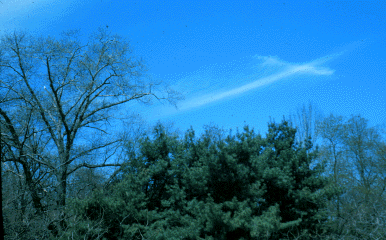
In this mode, artifacts also came to have a symbolical significance for us. Thus, for example, Boston's Hancock Tower became a ladder to heaven. A Large decorated public Christmas tree became an illuminative symbol of Our Lady's protecting mantle, extending from heaven to earth - the lights undulating in the wind symbolizing the movement of ministering hierarchies of angels between heaven and earth.
This sense of the splendor and power of Our Lady's heavenly mantle and its angelic fabric brought to mind the Spanish painting of Our Lady's Mantle protectively overshadowing Columbus' Santa Maria and other two ships as they set sail in 1492. We then recalled the Russian tradition that Satan would be converted at the end of the world, and the prophecy that Mary, having constrained him with her heel during the course of Redemption history, would mediate this conversion by encompassing him in her mantle and with it lift him upon the Cross, as Moses lifted up the serpent in the desert - that all evil would be expiated and not co-exist with heaven for all eternity.
A culminating artifact was one seen to symbolize the Trinity: a large demonstration model of a laser in the Boston Museum of Science. Light (the "Holy Spirit") originating from a source at one mirror (the "Father"), was reflected from a second mirror (the "Son") - oscillating back and forth with ever increasing intensity, between the two "ad intra" - until it burst forth through an aperture in the second (the "Word, through whom all things were made"): spiraling to and circulating "ad extra" in Creation.
Through our own experience was thus realized, our broader vision and hope of Mary's Gardens, as described by Robert Ostermann in his 1953 Irish Ecclesiastical Record article, "Mary's Gardens":
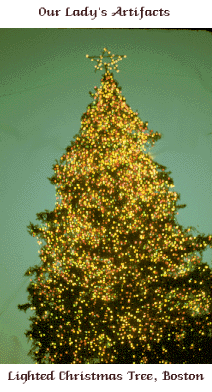
"The ultimate objective is not merely to call public notice to the Lady-names of flowers. That is but the opening wedge, one means . . . 'of restoring the prayerful, religious sense and true dignity to gardening,' in its turn one means to fill the whole of life with its vast abandoned content of religious meaning."
As our hearts are thus raised in love and thanksgiving to God through the illuminative resplendence of Christian nature symbolism, we, in emulation of Mary, enter into spiritual communion with the creative munificence of the Father, with the redeeming sacrifice of the Son, and with the sanctifying and renewing inspiration and promptings of the Holy Spirit - from which, in grateful and compassionate return of love, we turn ever more fully to the works of mercy and the culminative building of the Peaceable Kingdom of truth, justice, love and freedom, on earth as it is in heaven, for the fullest showing forth, sharing and mirroring back of God's glory.
We do this in emulation of Mary, the Mystical Rose, mindful of the reading from St. Amadeus of Lausanne in The Liturgy of the Hours for the feast of the Queenship of Mary, August 22nd:
"…while still in the flesh...at one moment she withdrew to God in ecstasy; at the next she would bend down to her neighbors with indescribable love. . . ."
Copyright 1997, Mary's Gardens
All About Mary includes a variety of content, much of which reflects the expertise, interpretations and opinions of the individual authors and not necessarily of the Marian Library or the University of Dayton. Please share feedback or suggestions with marianlibrary@udayton.edu.
